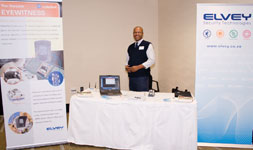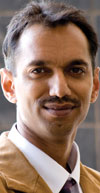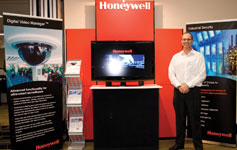
The iLegal 2009 conference was a roaring success as it provided the groundwork for the most effective and legal surveillance practices and tips to ensure video evidence is admissible and usable in court. As with most issues in security, if your operational processes are right, you are 80% there.
The use of CCTV in all its forms is growing in leaps and bounds, even in the global recession. But while most of the surveillance decision-making processes focus on brand, technology and money, more business leaders are voicing concerns when it comes to the legality of their surveillance, the admissibility of video footage in court and their companies’ potential liability in an environment that has no clear legal guidelines.
Hosted once again by Dr Craig Donald, the iLegal 2009 conference continued the trend it set in 2008 in bringing experts from various fields together to deal with these issues, answering many of the surveillance questions managers have asked, and some questions not yet raised.

The 2009 conference focused on running CCTV and surveillance projects with the goal of being able to use the footage for prevention, and if not possible, successful prosecutions whether within companies or in court.
The necessity of a conference such as this was highlighted by the fact that despite turning late registrations down, additional chairs had to be brought into the hall to accommodate all those who turned up. The conference was opened by Michael Broughton from the Crime Prevention Unit of the Consumer Goods Council of South Africa.

It is up to each one of us
Broughton introduced the conference noting the impressive number of people present, including a significant contingent from SAPS. He also noted the conference was not a venue to discuss theory, but to share best practices and advice the delegates could take away and apply in their environments.

Broughton’s focus was that the spiralling crime statistics are a clear indication that we are not to leave everything to SAPS and complain when they do not do a good job. Crime is something we all need to get involved in preventing and controlling through better operational processes and technology. A cooperative effort will see everyone involved in crime prevention, with the police participating where they can add value and do what they are trained to do, while we play a role in supporting them.
Part of this cooperation is education. Businesses and individuals need to know what they can and should do to make it harder for criminals and safer for themselves, and then they need to do it. He stressed that this includes the so-called soft crimes that individuals and communities turn a blind eye to. By allowing crimes we accept, such as ignoring road rules or illegally copying songs from the Internet simply inculcates a culture of being soft on crime. And this is a culture that grows, no matter how irrelevant it seems.
The security industry has a role to play in preventing crime, even going as far as working with competitors for the ultimate benefit of the communities they serve. And we also need to focus on implementing and sharing best practices with each other – if something works, share it. We all win that way.
Broughton was followed by Thys Le Grange, group technical director at Omega International Associates. Le Grange spoke on the lessons learned in real-world macro surveillance projects.

Surveillance is only the first step
Omega runs the city surveillance project for the Johannesburg central business district (CBD) and Le Grange was able to show numerous examples of how surveillance footage has helped citizens. The footage is mostly crime related, but there are also non-crime issues it deals with, like a citizen having a heart attack in the middle of the road or another that needed medical attention after an idiot drove over her while on his cellular phone.
CCTV surveillance is becoming more popular because the effectiveness of guards is limited. Le Grange says crime is a business and the criminal planners cover every angle before acting. CCTV is therefore a better solution as cameras can cover a wider area than a guard, zoom in where necessary and the viewers are safe in a control centre. Omega trains its operators to not only focus on crime, but also to identify potential crime scenarios by watching the body language of people and their activities.
The company does not get involved in crime fighting, but has police officers in the control centre that can judge a situation and call for the appropriate resources. Le Grange says this cooperation is crucial to the success of the venture.
He also noted that even though operators are not out in the field, their training and commitment to the job is of paramount importance. Omega operators undergo over one year of training before hitting the screens. The company’s operators are also 'street-wise', knowing what to look for in order to act proactively and prevent incidents where possible. For example, when the street hawkers pack up to leave you know something is about to happen.
Not only do surveillance operations need to implement best practices in their control rooms, but also beyond the immediate surveillance. To ensure footage is admissible in court, the evidence must be carefully preserved so that no person is able to tamper with it – and the processes must be designed that this tamper-proof status stands up in court. Omega keeps digital recordings of all its surveillance in a fireproof vault. It currently has no policy for destroying video after a set number of years.
Legally, Le Grange says people must be notified by signage that they are under surveillance. His company, however, has not had any negative reactions on privacy issues even after years of operations. He does note, however, that there can be a problem if one records audio when not a party to the conversation.
Key to Omega’s success is its policies, procedures and processes. Le Grange stressed the importance of planning, implementation and maintaining these over the long term.
Sonja de Klerk, director of scientific analysis, at the SAPS Forensic Science Laboratory, dealt with the issue of how to ensure CCTV footage is accepted in criminal or disciplinary cases in the next presentation.

Manage the evidence process
De Klerk’s presentation focused intently on ensuring that video evidence is usable for official proceedings. Here again, the standard operating processes (SOPs) involved in collecting and securing this evidence are paramount to a successful conviction. The two primary steps in this process are assuring the chain of evidence and assuring the chain of custody.
Assuring the chain of evidence comprises immediately determining and recording what happened, when it happened (date and time), who reported the incident and which cameras captured the incident. Each incident needs to be identifiable by a unique case or internal reference number which is linked to all evidence, video or otherwise.
When video is captured on hard disk, the serial number must be recorded, when recorded onto CD or DVD, the unique number on each disc should also be recorded to prove that device is the master copy. She recommends downloading the footage as soon after the incident as possible and making two copies, recording the date and time, as well as who made the copies. The master copies must be clearly marked as such. One then needs to be sealed in an evidence bag and handed over to SAPS, while the other needs to be kept in a safe – again with clear records of who put it there, who has access and so forth. Working copies can be made, marked as such and distributed to all role players.
De Klerk noted that the chain of custody could be summed up as follows:
* What was collected?
* By whom?
* When?
* Why?
It is important to keep the chain of custody short to avoid the potential of tampering and to ensure only trained staff handle those issues within their gambit. The more people touching the evidence the better chance for a defence attorney to infer tampering or poor evidence management. Ensuring the people involved in the chains of evidence and custody are properly trained to handle the tasks is crucial to a fairly smooth prosecution.
Some of the problems the forensic laboratory often run into when processing video evidence that make it difficult to use the relevant footage in court include companies that do not have a documented chain of evidence or custody. CDs or DVDs marked on the wrong side and, occasionally, the master copy was not secured making it impossible to determine if tampering occurred or not. Additionally, sometimes the surveillance systems have not been tested resulting in there being no footage to examine.
Additionally, while some surveillance vendors shout loudly about open standards and interoperability, using software and hardware systems that adhere to standards is crucial to ensuring everybody is able to view the footage easily with the applications readily available to them.
Summing up, De Klerk warned, “Evidence cannot be presumed to be evident. It must be proven. It must be documented and demonstrated”.
Someone with ample experience in using video footage in a distributed corporate environment, Sam Moodley, manager of the Asset & Revenue Protection Services (TARPS) at Telkom SA followed with a case study of the use of CCTV footage in this giant organisation.

Monitoring multiple locations and thousands of employees
Telkom’s challenges have evolved as the company, like many alongside it, has been swept up in the technology revolution. Moodley aptly notes that while technology may be evolving, so too is the world’s criminal element. Because South Africa has such a dynamic criminal environment, its people have to evolve with it, or be crushed by it.
The rise of CCTV technology in Telkom has been peppered with many challenges. “We first started with legacy systems,” explains Moodley. “There was no centralised CCTV camera system then. Cameras were decentralised, which resulted in an endless stream of management and operations issues. There were often delays in evidence gathering and the cost of data retrieval was high. This environment was ultimately less secure and open to collusion.”
When Telkom took the decision to implement a surveillance nerve centre, it changed the face of CCTV camera technology within the company forever. Moodley refers to the centre’s role as that of a ‘Master/Slave’ scenario – the nerve centre in Pretoria being surrounded by hundreds of satellite hubs dotted around the country. Pretoria was chosen as the location for the nerve centre as it had to be in an environment that was well controlled.
Aside from the initial challenge of convincing management to buy into the concept, there was yet another thorny issue to deal with, and that was the privacy issue. “We had to convince our staff that CCTV cameras were not being installed to monitor their every move but rather to protect them if there was an incident,” Moodley explains. “It is all about mindset; changing the way people think about a solution.”
Moodley stressed the need for proper deployment of CCTV camera technology. “Whatever system we deploy must provide tangible evidence that can actually be used. It is very easy to let this slip up,” he says.
Due to the nature of Telkom’s varied sites, many of which are situated remotely, the alarm, incident handling and evidence gathering are vital. CCTV cameras allow for live communication feed in remote areas, enabling better management of a crisis from the central observation point while eliminating guard vulnerability. “You simply cannot put a lone guard on an unprotected site,” says Moodley.
Camera criteria for Telkom
Critical characteristics of CCTV Camera technology for Telkom include:
* Reliability.
* Connectivity – no dependencies.
* Low bandwidth consumption – there is simply not enough adequate bandwidth available for all the cameras Telkom would like to deploy.
* Good picture quality – very important in terms of court certification.
* International court certification.
* Local support and repair centres – the aim is to have minimum downtime.
* Live picture transmission.
* Cost-effective solution.
* Forward and backward compatibility.
Moodley highlighted the need for constant refresher training and operational changes in the nerve centre, due to the high levels of staff attrition. While operators may acquire a highly skilled job by working in a centre, the work does become monotonous. Telkom therefore varies the operators’ work. “We may also move him from an operational environment to a technical environment the following month, all in aid of preventing monotony,” explains Moodley.
Moodley and his team believe that they need to constantly review their CCTV technology processes. “We recommend bi-annual reviews,” he says. “A technology design in a building needs to be constantly revisited because that building may have changed structurally, which in turn would affect the correct positioning of the cameras.”
Summing up his presentation, Moodley leaves the audience with the following words: “It is about implementing an integrated technology program that has sustainability with prospects of further development as technology and demands evolve.”
Taking a leaf from the UK’s surveillance book, the keynote presentation followed with an insight into how the UK Metropolitan Police force is using CCTV to bring different departments together in the fight against crime.

Do not be fooled
Do not be fooled was the underlying message from keynote speakers Mick Neville and Gemma Havard. Their message warned that whilst CCTV camera technology is a fantastic tool, it is only effective if used correctly. Neville examined why Britain, with a million cameras deployed countrywide to protect its population, is failing to utilise the tool to its full capacity.


Based on hard facts from their experience in the United Kingdom, Neville’s accounts of poor CCTV practice were a revelation to say the least. He did not paint a pretty picture, alerting his audience to the fact that for every 1000 cameras deployed in the UK, only one crime is solved. As a result, CCTV technology can be a costly and ineffectual tool to both the taxpayer and the individual if deployed as carelessly as it currently is.
Where are the flaws?
Public confidence in CCTV cameras is, according to Neville, falling to an all time low in Britain. “Complaints about CCTV systems have gone up ten-fold,” he confirms, adding that unless CCTV systems first do the job of detecting crime, they will not succeed in preventing it. Neville stressed the need for police officers to set up good partnerships and management processes to work alongside the CCTV tool. Without these, camera footage alone is worthless. Key criteria that he identifies includes:
Ensuring cameras generate the right kind of image
CCTV evidence is dependent on the quality of the image caught on camera, and obtaining quality is not, according to Neville, an easy task. One only has to look at the statistics, he said, to realise the reality of this problem:
* Only about one in a 1000 CCTV images is seen live.
* Only 3% of arrests for robbery result from CCTV exposure.
* Only 5% of robberies on buses are solved through CCTV footage.
* 80% of images are not useful. CCTV users need to understand the importance of position, when setting up their cameras, he explained, adding that too many people mistakenly set their cameras too far back in order to try to film everything in the field of view. What they do not realise is that this in fact reduces clarity or clear focus. Neville stressed the point that the quality of the CCTV footage would ultimately determine how the police use the image to further investigate an offence and identify suspects. The images can, if good quality, also be used to publicly expose the criminal via the media.
Managing images better
According to Neville, police detectives need to manage their images and consequently their evidence, better. There are many ways in which CCTV footage can be used to help a case, he explains, highlighting logo recognition as one such example.
Neville adds that police need to compare criminal mug shots with CCTV footage more thoroughly. “Identify and take note of an individual’s clothing. You would be surprised how an offender will be wearing the same jersey or cap, during a second offence.”
Implications of video analysis on criminal behaviour and police investigation
Up to half a billion pounds have been spent on lining England’s streets with in excess of a million cameras, yet, argues Neville, police investigators are relying too much on the cameras to do their investigative research. Not only are cameras now being viewed as a crime prevention device by the public, they are also being viewed as a crime solutions device by police officers investigating a crime. “This is changing the way the investigator operates both at the scene of a crime, and during the investigation,” he argues. “And it is this that is the systems' fatal flaw.
“In the past officers were trained to take fingerprints and analyse a crime scene thoroughly, collecting all matter of evidence. Officers became specialists in their investigative roles. Now, the concept of ‘it is captured on camera so we do not need to investigate’ has become an all too common phrase,” he laments.
Neville says criminals show little fear of CCTV cameras – what they do fear, however, is fingerprint and DNA evidence. “Police officers need to reinstate the importance of detailed investigation,” he argues.
Using CCTV evidence in police stations and courts
If a court wants to see images, they should be readily available and docketed correctly. Sentencing (and often longer sentencing) can occur due to good CCTV evidence being provided in court. Police officers need to have this evidence displayed correctly, for example handing in only the original copy of the images as evidence. Secondly, officers and lawyers should always make a point of checking that the court has the right equipment available to view these images (often they do not, even in the UK).
In conclusion, both Neville and Havard identified the following solutions in order for the CCTV camera solutions to play an effective role in combating and identifying crime:
Investigation: A full investigation must take place alongside CCTV footage.
Partnership: Working partnerships should be formed with the main CCTV suppliers. “Detectives can make excuses,” says Neville. “We have found only 4% of evidence comes from the control rooms.” It is imperative that detectives go to the scene of the crime and look for the cameras in order to check whether a crime could in actual fact have been caught on camera, and if so, why it was not.
Metropolitan circulation: Images of wanted criminals need to be circulated as widely as possible via police and partners, rigorous poster campaigns and the media. This shows the public that the CCTV is on their side and that it works. On the other hand, it shows the criminal that the CCTV camera will eventually capture him. Posters create psychological warfare with the criminal.
Detective training and supervision: Police officers must do away with finding excuses not to carry out their investigative tasks properly. “All too often we hear the phrases: ‘I do not think it is the same man’ or ‘there is no point arresting him as he was only near the scene’, and ‘he is unlikely to admit it in the interview’ – this attitude must change.
Six minds are better than one
Following the keynote, the conference chairman, Dr Craig Donald, hosted six experts from various fields in a panel discussion. The delegates were given the opportunity to ask the panel to discuss questions and issues they had come across or had to deal with in their businesses. The panel consisted of the following people:
* Helaine Leggat: director of iForest Information Management, head of business services for Michalsons Attorneys and senior corporate legal advisor with Chetty Law.
* Bradley Scop: partner at Eversheds.
* Mike Barker: CCTV consultant.
* Supporting these experts were conference speakers Mick Neville, Sonja de Klerk and Per Björkdahl.
Five of the key questions discussed and answered by the panel are below:

1. What are the minimum requirements in terms of image quality for admission in court?
There is no minimum requirements for court-accepted images in terms of resolution or size. However, any images submitted must be usable; meaning the crime and perpetrators must be easily identifiable to the naked eye. It is also worth noting that often images that are not acceptable for court cases are often more than adequate to assist in directing authorities in successfully prosecuting a crime.
2. Do you have to put warning signs up?
In the strictest sense, you do not have to legally have CCTV warning signs in a building under surveillance, but the legal experts on the panel advised it was 'wise to do so'. Laws governing privacy and the interception of information should ensure that companies obtain consent to record people on their premises, This is tacitly done by advising them that they are under surveillance with well-placed signs. It is similar to a sign in a parking lot saying 'parking at own risk' – the driver accepts that the owner of the lot is not responsible for anything that happens to his/her car. To be less subtle, visitors may be informed and sign consent when they enter their details into a visitor’s book.
Always remember that there must be a purpose for collecting information and it must be kept only for as long as the purpose is valid.
3. When is CCTV illegal?
The concept of 'fairness' in terms of the Labour Law must be adhered to when recording worker activities. Once again, filming, recording or intercepting without previous consent is illegal unless part of an official and properly planned investigation. In the workplace, consent is usually obtained in the letter of appointment.
Businesses must also take cognisance of a person’s reasonable expectation of privacy, such as bedrooms and bathrooms. There must be an element of reasonableness in the recording. Interestingly, the recording of audio is banned in the UK except in specific circumstances.
4. Are watermarks necessary to enhance the status of evidence?
The short answer is no. Always remember that you should only present in court what you can explain. If you get your evidence processes and procedures right, a watermark is just another complication to explain.
5. Encryption: does it change the legal status of recorded evidence?
Encryption does not change the legal status of evidence, but it increases the legal admissibility since it prevents tampering. It supports the claim to authenticity.
Legal aspects of surveillance
Following the panel, Per Björkdahl, business development director from Axis Communications spoke about the legal aspects of surveillance specifically with respect to recording images that are admissible in court, specifically as they relate to the Scandinavian environment.

The issues facing businesses in Sweden running CCTV surveillance are fairly similar to those facing South African companies, with the exception that some of privacy laws in Sweden are stricter. Björkdahl notes that the key issues relating to admissible video evidence are that the surveillance system capturing the footage must be legitimate, the purpose of the surveillance system and use of footage from the system must be legitimate and viewers must be able to be able to make something out of the image. Moreover, the company submitting the images must be able to prove their origin and the reliability of the image.
So it is more than setting up a bunch of cameras and recording evidence. Looking at the technical aspects of surveillance, Björkdahl refers to a 2005 report on video surveillance in retail from the The Swedish National Laboratory of Forensic Science, which noted: “The footage is in principle useless due to insufficient image quality as a result of poor camera placement or technical limitations.”
As part of the SOPs involved in surveillance, companies need to ensure their cameras are located in the right position and height to gather usable data. More than that, making sure the cameras you choose are able to collect images of sufficient quality in the respective lighting conditions is also of paramount importance. A betting shop in the UK thought it had surveillance as a security measure in 1999, however, after 100 robberies the business found only four had video footage and none of them was admissible because of poor quality. Purchase cameras that will work as desired in your specific conditions.
Björkdahl also brought in the benefits of high-definition in the surveillance world. One benefit is that HD boasts five-times more pixels that traditional video footage, offering five-times the resolution and information in each image. The 16:9 format also covers a wider area, again incorporating better images of the broader area under surveillance.
The final presentation for the day was from Clinton Vigne, specialist investigator at Montecasino who spoke on how to prepare CCTV operators for their day in court. It is all very well collecting video evidence, but how will your operators stand up under hostile cross-examination?

Protecting operators and evidence in court proceedings
While it would be convenient to simply offer video footage as evidence, defence lawyers are not inclined to accept these images when they implicate their clients. Their job is therefore to attack the reliability of the evidence by attacking the operating processes involved in collecting it. If this fails, the next step is to attack the credibility of the witness (the operator). It may not be ethical, but that is how it works.
To prepare operators for their day in court, companies need to first explain the manner in which the proceedings will occur, who the role players are and how to address the presiding officer – 'Your Honour' only works on television. The operator must also revise what statements he/she made and the evidence submitted. First timers should also be given a taste of what the cross examination could entail in a safe environment.
Crucial to successful testimony is teaching the operator to refrain from getting into a conversation, or even worse, an argument with the defence. Answers should be kept simple and witnesses must stay within their area of knowledge. Do not make assumptions, if a question is confusing or unclear, ask for clarification. Always address the presiding officer and give your account slowly and clearly, do not elaborate or volunteer information. Be logical in your representation of the facts and never allow the defence to force a yes or no answer from you – the witness has a right to answer a question fully.
The defence may try to trick the witness, confuse him and offer leading or suggestive questions or cast doubt on his testimony. It is imperative therefore to carefully consider the questions before answering and to ensure your answer is simple, to the point and accurate. Never get into an argument with the defence and never lie.
Finally, Vigne advises that witnesses must be taught never to answer a question from the defence in the corridor unless the prosecutor is there, never get into an argument (you will lose), never be rude or sarcastic, never try to answer a question they do not know the answer to, never make speeches and never hide anything from the prosecutor.
The do’s of testifying in court
* Always remain calm and composed.
* Always give evidence impartially.
* Always give a direct answer.
* Always tell the truth.
Source: Clinton Vigne
With the final presentation done, Craig Donald closed the conference, thanking the speakers and exhibitors, inviting everyone to the networking session. The feedback received from the delegates was positive and has already raised further questions to be dealt with in iLegal 2010.
| Tel: | +27 31 764 0593 |
| Email: | [email protected] |
| www: | www.technews.co.za |
| Articles: | More information and articles about Technews Publishing (SA Instrumentation & Control) |
© Technews Publishing (Pty) Ltd. | All Rights Reserved.